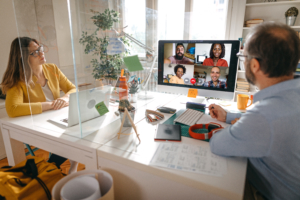As people return to high streets and services reopen, there’s no getting away from thoughts of coming back to the office.
While some await the green light from managers, and others consider how their work-life balance might change again, there’s planning going on behind the scenes. Organisations are getting ready for more workers to come back.
Recent research from Microsoft highlights that 66% of business leaders are redesigning physical spaces to accommodate hybrid working and improve staff retention. But this type of responsibility (that is, the employee experience) isn’t down to just the CEO, facilities and CHRO anymore. For too long, the chief information officer has been misconceived as “the person that makes the computers work”. The pandemic changed that.
As CIOs take on a broader role driving strategy and transformation, the skills they need are changing too. So alongside a requirement for knowledge of technology such as AI, CIOs also need soft skills.
It became clear during the latest CIO Institute event that skills and responsibilities have evolved in this way. Shikha Hornsey, Gareth Johns, Dave Roberts, Danny Attias and moderator Samuel Sonnenfield discussed the future of the office post-pandemic.
Create equal experiences for all
“We are going to be working in this hybrid environment where there are going to be people in the office, and there are going to be people working at home. We need to make sure that’s an inclusive experience. I’ve seen it in the past, in other organisations where there’s someone on the phone, and they don’t feel engaged in the meeting. We’re now going through how to set up our meeting rooms to ensure they are inclusive. We want to make sure that collaboration is equal,” Dave Roberts, global IT director at Stantec, commented.
Gareth Johns, senior director of vertical solutions at RingCentral, discussed why parity should be a top priority for companies that continue with remote working.
“Regardless of where people work from, parity of experience is needed. People who are remote shouldn’t have a second-class employee experience. Hopefully, when we go back into the office, we make sure the conversation is inclusive. Yes, there’s an element of this that technology can help with. There are things that providers are working on to make that more immersive. But it’s also on us as individuals to make this happen.”
Avoid transactional interactions
It’s so easy to become disconnected from each other in a remote or partially remote work environment. Despite technology being there for us to chat whenever we want, we need to work hard to keep connections we would normally make face-to-face.
“When life becomes a little more normal, I think we have to remember what it’s like to be remote because as human beings, we tend to forget. So we need to keep in the forefront of our mind what it’s like to be off-site and remote while others are on-site during meetings. We’ve all been there; the person who dialled into the meeting room almost routinely got overwritten or ignored, regardless of rank,” said Shikha Hornsey, chief digital and information officer at Crown Commercial Service.
On a similar thread, Gareth covered why we need to be informal sometimes and make an effort to check in and support employees:
“When we’re in an environment like this, our interactions become too transactional. With this, we lose some of the goodwill credit we build up from actually having social time to get to know each other.”
Be wary of burnout
Findings from Microsoft show that 73% of staff want flexible remote work in the future. This means they want to choose when they work remotely and when they go into the office, and the time of day they work.
Organisations must give employees the mental health support they need. Many have been struggling with technology overload for a while. This is why we’ve seen so many reports of burnout and people working longer hours since the pandemic hit.
The question is, how will organisations prevent burnout if employees are working from anywhere?
Introduce relevant policies
Organisations are creating all different types of hybrid or flexible working policies. For example, Alphabet CEO Sundar Pichai shared his return-to-work plans calling for roughly 60% of Googlers being in the office for a few days a week, while another 20% will work in new locations and 20% will work in their home offices.
The panellists agreed that there isn’t a one-size-fits-all approach, and leaders should take individual work-life balance seriously – regardless of the number of people in an organisation.
Shikha kicked off this discussion, “You should have corporate rules in place where you have what’s considered healthy work hours.”
Danny Attias, chief digital and information officer at Anthony Nolan, described the need for policies to ensure people aren’t overworked in the hybrid future, “We’ve [introduced] a policy where people will work at 80% efficiency for the next few months. Because they’re 100% is 120%. It’s not sustainable. We know it’s not sustainable because people are exhausted.”
Dave explained Santec would “have three days in the office and two days at home, but that will flex.”
That being said, some people need to be in the office every day because of their role. But Dave’s view is that ultimately all roles are going to change. CIOs will become the “enablers” of such changes.
Seek alternatives to physical workspaces
Traditionally, the office is a place where people create culture, share knowledge and inspire creativity. But will this be the case in the future if some employees don’t feel motivated to return to their desks?
“The Leesman Index found that there has to be a driver for people to go back into the workplace,” Gareth explained. “People will be asking if the physical workspace reaches their requirements. Unfortunately, not every organisation has got the funding for this.”
Ultimately, businesses will need to find ways for all workers to feel included post-covid, regardless of where they are. “The future workforce will need to have a common area, a common capability for people to share their experiences and knowledge.”
What will offices look like now that people are going back in?
In reality, there isn’t one clear answer because it’s going to be different for everyone. But we can map how technology is evolving and how companies could use it.
For example, in London, fintech firm Revolut overhauled its office space to include Rev Labs: flexible, collaborative zones for brainstorming and training whenever staff do go in. BaseKX, University College London’s startup hub for entrepreneurs, offers a snapshot of what the future workplace might look like. The hub is adopting meeting pods for more one-to-one conversations when using collaboration tech.
With more innovations on the way, we’re yet to see how companies beyond big tech firms create common areas for workers and the role CIOs will play in developing this for employees in the future.
Originally published Jun 08, 2021, updated Jun 14, 2021



